Ibiza Unveiled — A Local’s Offbeat Guide for Family Escapes, Out-of-Season Adventures, and Hidden Free Havens of an island in spring
By Virginia Melodia, Local Ibiza writer & time-traveling explorer of the island.
Virginia Melodia provides this magical article about the island of Ibiza, where she takes us back in time through forgotten landscapes, old clubs, secret sanctuaries, and wild art carved into the stone. Combining her local perspective with an exploratory soul, she invites us to discover an unknown and timeless Ibiza, far from the tourist bustle, where every corner is a sensorial portal to other eras and emotions.
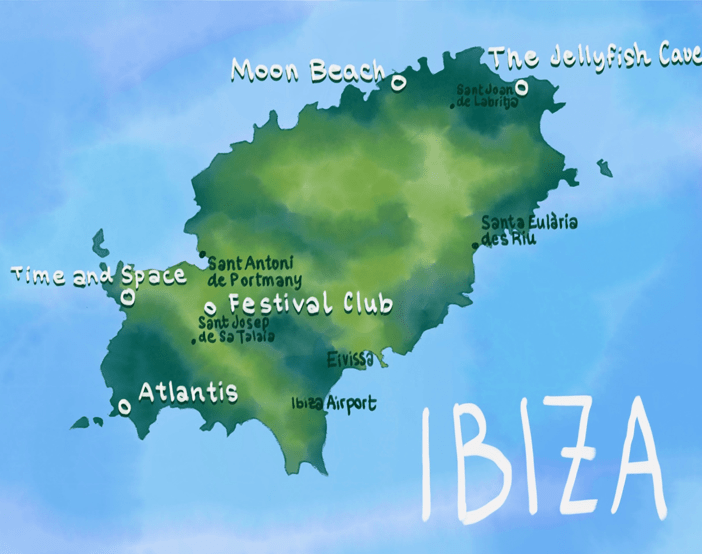
Festival Club
Nestled in the southern embrace of Ibiza, above the undulating hills of Sant Josep de Sa Talaia. Festival Club stands as a living testament to the island’s first nightclub.
Known among locals as a haven for contemporary expression, this once-pioneering establishment now graces the landscape with its weathered walls, transformed into an expansive open-air gallery adorned with the vibrant tapestry of graffiti and murals. A communal canvas, free and accessible to all, framed by natural surroundings that amplify its artistic resonance.
Festival Club emerged as an emblematic gathering place, born from the harmonious intersection of people seeking solace and a burgeoning community of free-spirited hippies. This convergence marked the genesis of tourism on the island.
In the year 1972, Festival Club opened its doors, a sprawling expanse that included an amphitheatre, a restaurant, and dance floors that echoed with the rhythmic pulse of revelry.
Within its open-air confines, thousands of souls revelled in wild abandon, engaging in vibrant soirées that transcended the ordinary. Music concerts, mock bullfighting, and mesmerizing performances became the fabric of this cultural sanctuary. Legends whisper of transcendent nights where Bob Marley and Jimi Hendrix graced the stage, a testament to the island’s magnetic pull-on global icons.
The venue, once a secluded enclave, soon became a beacon, drawing coachloads of international enthusiasts seeking the magic of its unrivalled ambience. Festival Club’s weathered visage not only echoes the vivacity of its past but also stands as a testament to the enduring spirit of Ibiza’s artistic and cultural evolution.
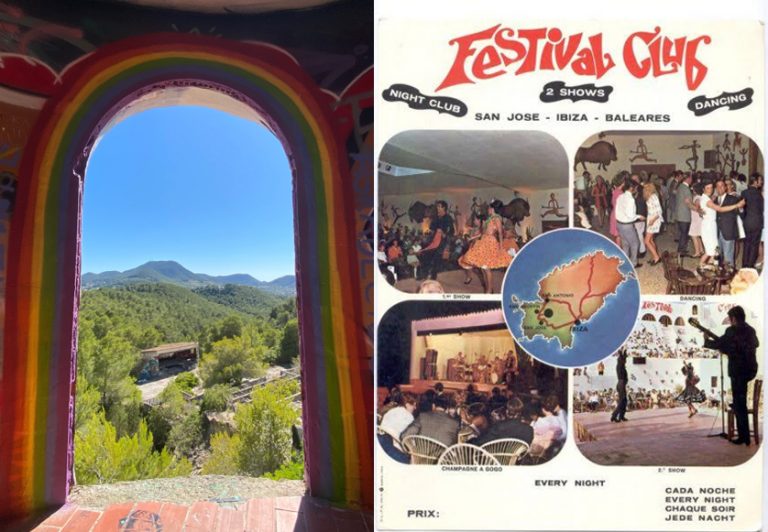
In 1974, the weight of accumulating debts, exacerbated by the preceding season’s oil crisis, cast a shadow over the once-vibrant club. The reverberations of financial strain forced its closure, and as the doors shut, nature seized the opportunity to reclaim this nocturnal sanctuary, transforming it into a dystopian playground for artists.
In the subsequent decades, the abandoned venue bore witness to the throbbing beats of wild raves during the anarchic 1980s and 1990s. It became a breeding ground for the nascent art form of graffiti, each spray-painted stroke telling a story of rebellion and uninhibited expression. However, the ascent of residential areas ushered in a symphony of noise complaints, sounding the official death knell for Ibiza’s original discotheque.
Today, this erstwhile dancefloor of dreams stands frozen in time, its structure adorned with a riot of colourful, psychedelic murals. Vegetation, tenacious and untamed, clings to the skeletal remains, weaving a tapestry of nature’s reclamation. The air carries a unique melange of scents, the pungent whiff of aged urine mingles with the earthy aroma of broken cement, providing a gritty sensory. Vintage cars, abandoned and crashed haphazardly, dot the landscape, evoking a sense of surrealism and mystery.
As you step into this enigmatic space, the echoes of bygone parties linger in the air, charging the atmosphere with an unmistakable energy. It’s a place of perpetual exploration, where the decayed roof reveals the sky overhead. Despite the collapse of most of its ruins, weathered stairs beckon upward to a second level, offering mesmerizing views of seemingly endless green hills, a panoramic testament to the passage of time and the enduring allure of a once thriving dancefloor.
Atlantis
Sa Pedrera de Cala d’Hort, fondly dubbed Atlantis, unravels its tale as an ancient sand quarry, its history etched in the very stones that once shaped the venerable Dalt Vila, the historic heart of Ibiza’s capital. Extracted from this hallowed ground were blocks of rocks, ferried by ships to fashion the architectural splendour that graces the city.
In the wake of this industrial past, Atlantis emerged a mosaic of asymmetrical cuts in the stone walls that, over time, metamorphosed into natural pools, brimming with the crystalline embrace of seawater.
Today, this site stands as a living canvas, an artwork waiting to be discovered. Wander through its labyrinth of rocks, stumble upon hidden pools, and find pockets of sand where you can recline and bask in the Mediterranean sun.
Yet, amid the daily stream of tourists passing by a secret lies concealed just beyond their gaze. To the left, before the path to the iconic Es Vedrà, a trail unveils itself a steep descent through the embrace of bushes, rocks, and soft white sand that drags you down, revealing the hidden site of Atlantis.
The air becomes infused with the earthy fragrance of the surrounding vegetation, the scent of wild bushes and the subtle aroma of the rocky terrain mingling harmoniously. The soft sand, underfoot, releases a delicate perfume that adds to the salty breeze washing on your face.

Guarded by the past, it invites you to walk into the footsteps of ancient times, to uncover the harmonious blend of history and nature sculpted into the very fabric of Sa Pedrera de Cala d’Hort, a place where the past whispers through the stones and the present beckons with untold wonders.
In the 1960s the free-spirited hippies of Ibiza discovered an unconventional meeting place. It was in the embrace of this quarry’s soft rock that they forged an extraordinary landscape, carving intricate shapes and whimsical faces into the malleable stone. What emerged from their creative hands was nothing short of a mesmerizing city-like structure, poised at the water’s edge. Wandering through Atlantis, you can still discover remnants of their communal expression; prayer flags fluttering in the breeze, paintings depicting deities, and, the fantastical semblance of a lost city, harmoniously etched into the blue and green tones of the landscape.
The beach stands as a living museum, where the artistry of the past converges with the present, a place where the legacy of the hippie mecca endures in the carved stones and the vivid expressions of a community that once found solace and inspiration in the rhythmic lull of the waves.
To get there, navigate towards Cala d’Hort on the PMV-803-1, and look for an inconspicuous dirt road veering off the main route. Follow the signs directing you to Torre des Savinar.
Upon locating the dirt road, continue in the little open area to park your car. Direct yourself on the main path, with the beach on your left and the tower standing sentinel in the distance, a small, hidden path will reveal itself, gently winding downhill.
Be forewarned, it is a hike that demands a bit of sturdy footwear. The descent is steep, and trainers are highly recommended. As you reach the shores of Atlantis, take in the beauty, but remember, arm yourself with water, the journey back uphill is steeper. Step into Atlantis with adventure in your heart and practicality in your stride.
Moon Beach
Located in the tranquillity of Ibiza’s northern realms, on the route to Portinax, lies a road leading to Caló de S’Illa, affectionately known as Moon Beach. This rocky beach, swathed in secrecy, reveals a lunar dreamscape that transcends the ordinary, an otherworldly symphony that arouses the senses, ensnaring the observer in an ethereal dance with the cosmos.
As daylight retreats, the rocky sentinels, resembling celestial bodies, undergo a metamorphosis, casting a spell of Martian hues upon the landscape, an immersive experience that induces every facet of perception.
The sensation of traversing uncharted space envelops the soul. Amidst the wild north coast, Moon Beach stands as an enigma, a testament to the island’s best-kept secrets.
The symphony of senses awakens, urging exploration beyond the visible, plunging into the ineffable essence of the unknown.
To navigate this pilgrimage, drive towards Portinax, and take the initial left turn while tracing the right side of the road. Engage with a rugged dirt path. Persist on the main track, where a leftward turn unfolds discreet parking spots along the roadside.
The path descends to a sandy expanse, between rocks and trees, underfoot and fingertips, a small path guides the way to the cliff’s edge, where Moon Beach reveals itself. The terrain, a tangible narrative, demands a deliberate traverse, a sensory dance with the earthly elements.
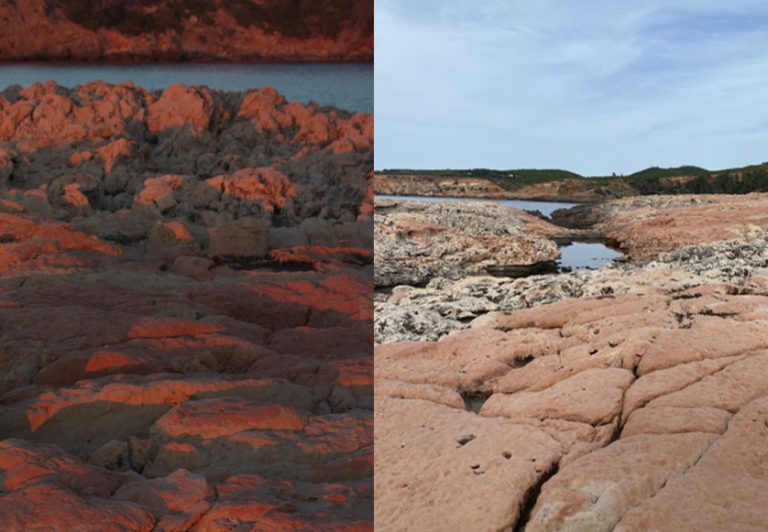
Moon Beach is a refuge from the fevered pulse of summer, veiled in secrecy and revealed only to those intuitively attuned to its spirit. The surrounding landscape, an ode to exploration, uncovers additional coastal wonders, an invitation for the eyes to feast on nature’s palette, from earthy oranges to soft pinks of the rocks and deep blues of the sea.
As the sun gracefully bows out, Moon Beach transfigures into a mesmerizing tableau. Pools form in the rock’s crevices, a sensory overture unfurling. The air, a composite of warm earth, pines, and salt, brushes the skin. The wind whispers through the trees, the water’s rhythmic embrace on the shore, an auditory symphony that grounds both body and soul.
This locale embodies an idyllic refuge for spending the night under the stars, by the coast, breathing in the saline air, witnessing the sun’s descent, and a gustatory interlude with the sea breeze.
Locals revere this sanctuary as a temple, a sacred space for moon rituals and solstice celebrations, a sensory communion with traditions passed down through generations.
At dusk, Moon Beach orchestrates a celebration of the day’s denouement, a moment to centre yourself, an immersive journey that transcends the commonplace. Surrendering to the magnetic beauty of the earth is inevitable here. Time relinquishes its grasp, and you will find yourself in a natural sanctum that not only captivates the eyes but permeates the sensory spectrum.
The bond with this place endures, drawing you back for consecutive days, an odyssey that tantalizes the senses and reveals the island’s vulnerable side, a side usually disclosed only to those instinctively aligned with its mystique.
The Jellyfish Cave
Cueva des Culleram, ‘la Medusa,’ a rocky secret echoing the graceful form of a jellyfish, lies nestled in the forgotten side of Ibiza’s northern sanctuary. This hidden revelation, an enigma whispered about but unknown even to the island’s discerning locals, remains tucked away in the folds of Sant Vicent de sa Cala.
To uncover the hidden cave, the route winds through the intricate turns leading to Racó de Sa Talaia. Ascending the undulating road over the hill, where each bend reveals new views of the vast sea, framed by the tall maritime pines. Gear up for a rocky ascent, shod in trainers to navigate the unmarked trail.
Guided by the heart-shaped orifice and assisted by a resilient rope, the final climb into the cave is both a physical and symbolic ascent into the mysteries concealed within.
As the narrow entrance is breached, Cueva des Culleram unfolds a symphony for the senses. A gentle breeze, orchestrated by the dual openings above and below, whispers tales of respite on scorching days.
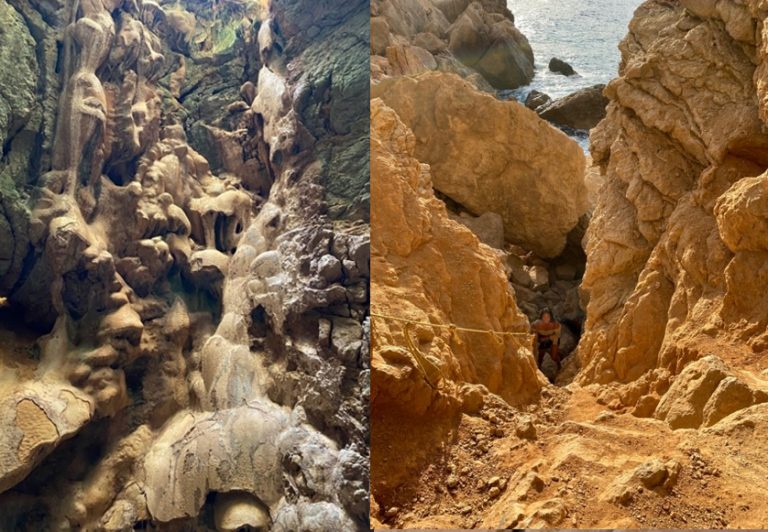
The limestone canvas, sculpted by the artistry of wind and water, unveils an ethereal palette, shades of green, yellow, and red cascading in a mesmerizing dance, akin to the undulating tentacles of jellyfish.
Stepping inside is an immersive experience where the oval recess, adorned with natural sculptures, mirrors a congregation of jellyfish in myriad dimensions. The air, laden with the complex melody of humidity, damp earth, and the invigorating scent of petrichor, unfolds like an unscripted poem, an olfactory tapestry transitioning from the sun-drenched beach to the cool, subterranean refuge.
Beneath your feet, the sand-laden floor invites repose, a tactile surrender to the raw beauty of the cave. As you recline, palpable energy establishes a connection with the limitless expanse of sky above, an ethereal communion that transcends the boundaries of the earthly sanctuary. The cave, with its cool embrace and vibrant hues, seems like an ancient storyteller, inviting contemplation and reflection.
In this unassuming alcove, echoes of tranquillity, profound history, and a cryptic past reverberate. The mind ponders, contemplating the cave’s inaugural discoverer and the epochs it has silently observed, a timeless witness to the island’s kaleidoscopic evolution. An enchanted subaqueous world reveals, a wonder through the details formed onto the rock, where water, as a master sculptor, shapes recognizable forms.
The cave metamorphoses into a subterranean grotto, a magical sanctuary resembling a siren’s home, an embodiment of the island’s enigmatic and immersive embrace, appealing not just to the senses but also to the narrative of time itself.
Time and Space
Often hailed as extra-terrestrial life or Ibizan Stonehenge, Time and Space emerges as a profound art installation, a creation by the globally acclaimed Australian artist Andrew Rogers, created in 2014. Perched on the cliff edge in the secluded bay of Calla Llentia, it asserts its presence amidst rugged outcrops and the crystalline sea, seemingly ascending from the island’s southwest coast, nestled alongside Cala Comte beach.
Rogers’ works, known for their colossal magnitude and scattered outdoor placements worldwide, unfold as visual poetry across diverse landscapes. Commissioned by the visionary founder of Cirque du Soleil, Guy Laliberté, a resident of Ibiza, the sculpture harmoniously resonates with Rogers’ Rhythms of Life series.
Time and Space stands as another work of art in this artistic worldwide collection of open-air sculpture. The artwork, a group of 13 pillars hewn from Turkish basalt stone, is a testament to meticulous craftsmanship. The colossal undertaking involved transporting 420 tons of stone across 4,400 kilometres of sea, each piece a sensory masterpiece. As you approach, the two doors will appear to you from the pines, by the fresh sea breeze mingling with the rhythmic crash of waves against the cliffs.
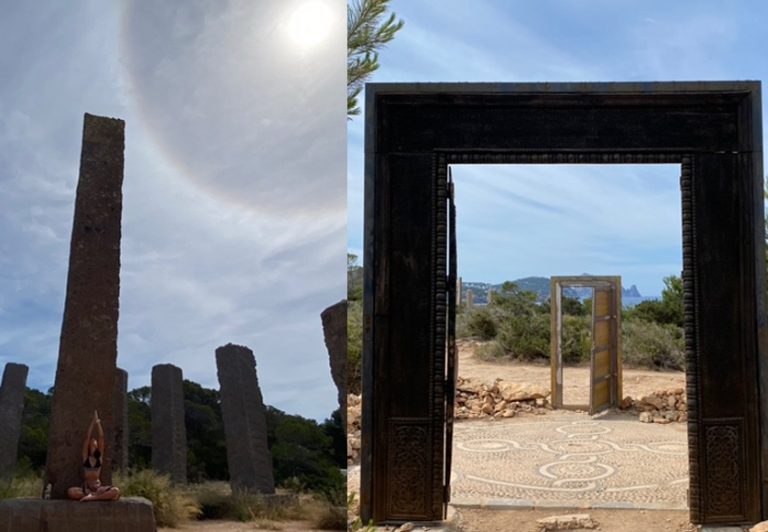
Spread across a diameter of 24 meters, the pillars elegantly adhere to the Fibonacci sequence, an unseen mathematical ballet manifest in the stone. At its core, the tallest column stands ten meters tall, crowned with a top adorned in 23-karat gold, a radiant homage to the sun. The gleaming summit shines bright as the sun’s farewell on the Winter Solstice.
This fusion of precision, mathematical elegance, and artistic vision transforms Time and Space into a mesmerizing testament to the interconnectedness of cosmic design. The journey to uncover its secrets, an exploration into the discoveries of the island’s wonders, transporting you into another dimension.
As the sun dips below the horizon, casting a kaleidoscope of hues upon the sea, the sculpture transforms. Time and Space transcends the conventional notion of a solar clock, offering a tangible representation of our solar system, with the columns symbolizing the planets gracefully orbiting the sun. Standing in the circle of these majestic columns, you will feel as if the earth is drowning you in the sky, like a magnetic pulse.
The walk is located at a spot where the sun sets into the sea, at dusk, the art transcends into a mystical reality, Time and Space unfold into a parallel world through the two doors, and the warmth of the sun brings out the golden tones of the main column, shining bright back at the water, the sand transforms into hues of orange and red, enhancing the smells of the surrounding vegetation.
As you pass through the portals, you will discover mandalas crafted from stones along the path, a communal canvas where each visitor adds their unique artistic contribution.
The magnetic energy exuded by the columns creates an atmosphere that is both captivating and potent. The air, imbued with the saline essence of the sea and earth, guides you through the interwoven sphere of art, nature, and cosmic mysteries.
